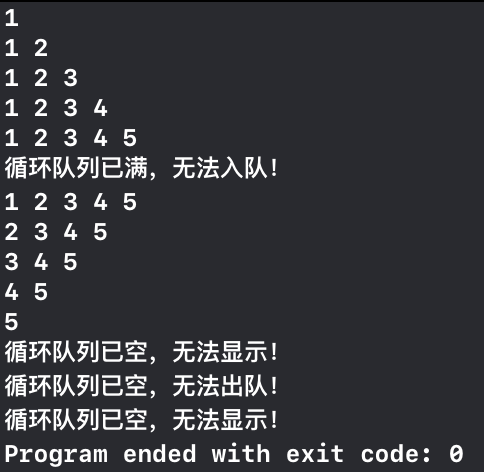用数组模拟队列时,我们为了避免数据移动及假溢出而使用循环队列,即当插入数据已经位于数组尾部的下一个位置时,若数组头部有空闲空间,则插入到数组头部;删除时,若删除的元素位于数组尾部,则删除后将队首头移动到数组的头部。为了区分队空还是队满,我们还需要使用一个空闲元素。
#include <bits/stdc++.h>
using namespace std;
class CircularQueue //顺序队列必须为循环队列
{
public:
CircularQueue(int length) //length代表存放最大元素的个数
{
p = new int[length+1]();
this->len = length+1;
this->front = this->rear = 0;
this->cnt = 0;
}
bool in(int num);
bool out();
bool isFull();
bool isEmpty();
int getLength()
{ return this->cnt; } //获取队列长度
void show();
~CircularQueue()
{
delete [] p;
}
private:
int rear; //指向队尾元素的后一个
int front; //队首
int len; //数组长度
int cnt; //队列中有效元素个数
int * p; //用于模拟队列数组的首地址
};
bool CircularQueue::isEmpty()
{
if (rear == front)
return true;
else
return false;
}
bool CircularQueue::isFull()
{
if ((rear+1) % len == front)
return true;
else
return false;
}
bool CircularQueue::in(int num)
{
if (this->isFull())
{
cout<<"循环队列已满,无法入队!"<<endl;
return false;
}
*(p+rear) = num;
rear = (rear+1) % len; //注意该行不能单纯rear++,否则数组会越界
cnt++;
return true;
}
bool CircularQueue::out()
{
if (this->isEmpty())
{
cout<<"循环队列已空,无法出队!"<<endl;
return false;
}
front = (front+1) % len; //注意该行不能单纯front++,否则数组会越界
cnt--;
return true;
}
void CircularQueue::show()
{
if (this->isEmpty())
{
cout<<"循环队列已空,无法显示!"<<endl;
return;
}
for (int i = front; i != rear; i = (i+1) % len)
{
cout<<*(p+i)<<" ";
}
cout<<endl;
}
int main()
{
CircularQueue q(5);
for (int i = 1; i <= 6; i++)
{
q.in(i);
q.show();
}
for (int i = 1; i <= 6; i++)
{
q.out();
q.show();
}
return 0;
}main函数中的测试代码运行结果如下:
